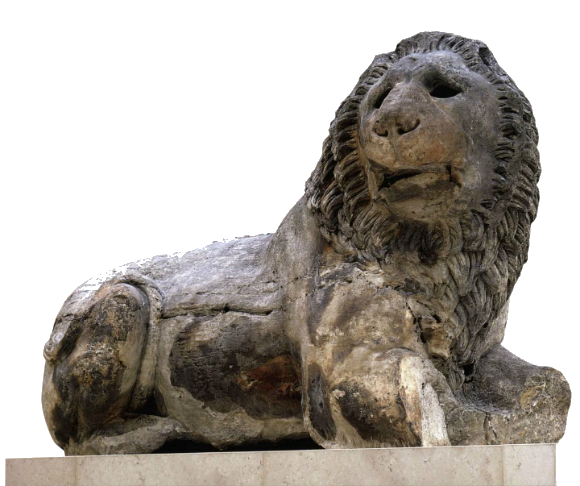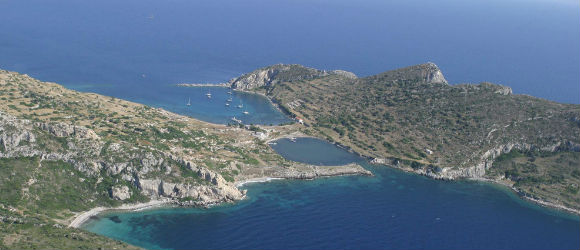The first location of Cnidus was half-way along the Datca peninsula. The residents moved it to its present site both on the Island of Tropium and on the mainland in about 365 B.C. The island is now connected to the mainland by a low, narrow isthmus which forms two small good harbors. Its citizens grew wealthy from commerce; the peninsula was famous for its wine. It was a center of culture: two theaters and an odeum suggest many hours of entertainment.
The city also had a good medical school. Praxiteles’ most famous statue, that of the nude Aphrodite, was bought by the city after the people of Cos rejected it in favor of a more modest and less celebrated woman. The original of the Cnidus statue is still being hunted; the best copy is in the Vatican Museum.
Ctesias, the Persian historian, was a native of Cnidus as was Sostratus, the builder of the Pharos at Alexandria. The Pharos was a lighthouse considered one of the Seven Wonders of the ancient world. Eudoxus, one of the great astronomers, was also born in Cnidus. He perhaps was the head of Plato’s Academy when Aristotle joined it in Plato’s absence in 367 B.C. Eudoxus had his own school later in Cyzicus. He made a map of the stars and invented the horizontal sun dial.
There were a number of temples in the city, among them ones to Dionysus and Aphrodite. Games were celebrated there in honor of Apollo and Poseidon. The agora, the Temple of Aphrodite, the odeum, and two theaters can be seen in the ruins, thanks to recent excavations.
Cnidus was the last landfall mentioned in Asia Minor in Paul’s journey from Jerusalem to Rome. He had been put on an Egyptian ship in Myra which sailed up the coast to Cnidus; because of headwinds they took a good many days to reach it (Acts 27:7). They probably did not anchor there because of the inclement weather which continued and in fact got much worse. Instead, they went on to Fair Havens in Crete where Paul advised them to winter, but, a southerly breeze springing up, the captain put out to sea again hoping for a better harbor. The wind changed and “for days on end there was no sign of either sun or stars, a great storm was raging, and our last hopes of coming through alive began to fade” (Acts 27:20).
They had run out of food before Paul saw a vision in which he was promised safe journey for himself and all on board. After two weeks they were shipwrecked, but all were saved: some swam to land, some paddled ashore on planks or parts of the broken ship. It was the island of Malta where they landed and then spent the winter. With better weather they continued on to Rome where according to tradition Paul immeasurably strenghtened the church, wrote some of his undying letters, was tried as an incendiary in the great fire during the reign of Nero, and was executed.

Knidos Lion “This colossal lion weighs some six tons. Made from one piece of marble, it was mounted on a base crowning a funerary monument. The monument itself was square with a circular interior chamber and a stepped-pyramid roof. It is a type of funerary monument inspired by the greater tomb of Maussollos, built about 350 BC”



Artefacts in Knidos could have been better presented. Presenting the rich history with vibrant culture may have placed Datca on the world map.
You travel 40km's to visit an ancient city established by the seaside. I don't advise you travel there at nook as it might be really hot and there are not too much shadows to have a rest.
We are true Datca fans by now. To me, Datca has the best sea among all Turkish coasts. Very peaceful, easy going, friendly and beautiful place. The place to detox your soul.
This is an amazing Ancient Greek archaeological site. Its two amphiteatres suggests the scale of this ancient city. It's a real adventure to wander round the overgrown ruins (not the best maintained of sites, but that's sort of its charm) and the setting on the south-westernmost point of Turkey is magnificent. A must-see adventure for anyone visiting this part of…
worth a visit, we travelled by boat so only got to spend 1hr there so no where near long enough would recommend visit by car
the history is amazing and a must for any history buffs
I always love wandering around Greek ruins, this isn't the best but the sunset from here is just stunning, not to be missed!
4,000 year old once dynamic and prospering city, the ruins still being unearthed. It takes a good 3 hours to tour. Wonderful setting, so tranquil. Two harbours from classical times, they don't look sheltered but they are. This is a beautiful place. The dockside berthing was very efficiently handled for us too.
Ashore is a real gem of a taverna…
After a long weekend in Istanbul, Datca is an unexpected but added bonus for us. we were there with the group of friend. First of all I'd like to suggest you to visit knidos with the boat, if you can.. if not there is a narrow, little hard rod is waiting for you. Knidos was a nice and rich city…
A 45-minute drive out along a winding and rutted road, through a couple of timeless villages, takes you to the site. Most of our fellow-visitors seemed to be from the various yachts anchored in the bay. It was too hot to explore entirely, but the quiet and the land/sea-scape made it well worth the trip.
Öncelikle knidos antik kenti cok onemli ve cok degerli bir antik kenttir. Badem cicekleri ve zeytin agacları arasından giden zevkli fakat bi o kdr da dar bir yol. Karsıdan nseidos adası rahatca gorulebilior yolda giderken. İçerisi bir o kdr harika cunku gecmiste insan kavimleri yasadıgı için guzel ama turkce acıklama nerdeyse hic yok gbi bi sey. Cogunlukla ingilizce, almanca ve…